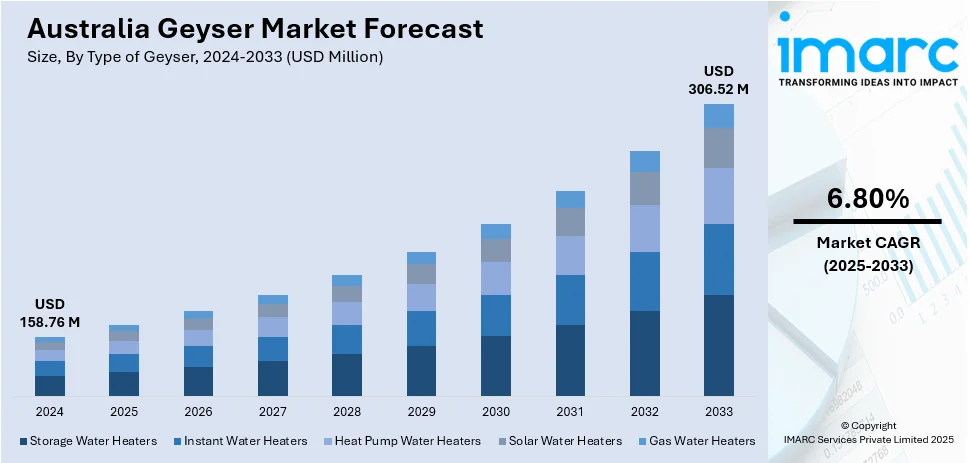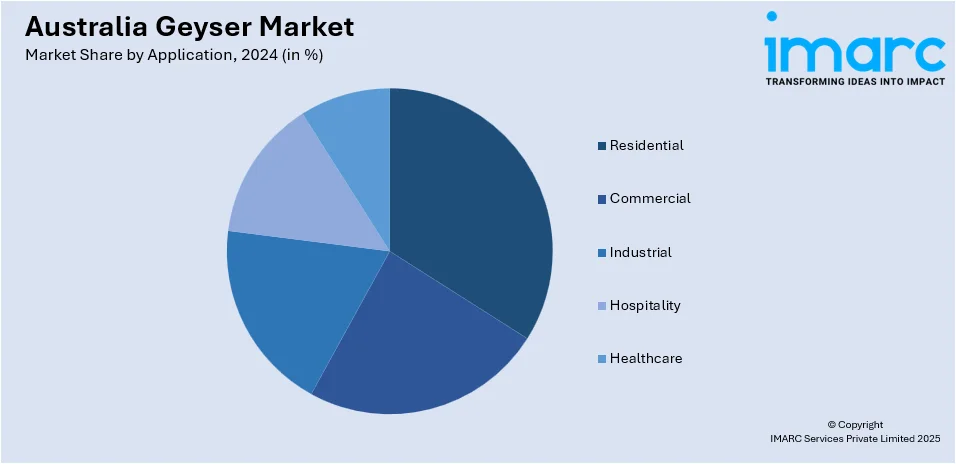
Australia Geyser Market Size, Share, Trends and Forecast by Type of Geyser, Capacity, Energy Source, Application, and Region, 2025-2033
Australia Geyser Market Overview:
The Australia geyser market size reached USD 158.76 Million in 2024. Looking forward, IMARC Group expects the market to reach USD 306.52 Million by 2033, exhibiting a growth rate (CAGR) of 6.80% during 2025-2033. The market is transforming with an emphasis on energy-efficient systems, the integration of smart technology, and growing the use of solar water heaters. Customers are giving value to reducing energy consumption through solutions that are convenient and sustainable. Improved heat pump technology and digital control are being driven by demand, coupled with government incentives for using renewable energy. All these trends combined contribute to the consistent growth and competitiveness of the Australia geyser market share.
|
Report Attribute
|
Key Statistics
|
|---|---|
|
Base Year
|
2024 |
|
Forecast Years
|
2025-2033
|
|
Historical Years
|
2019-2024
|
| Market Size in 2024 | USD 158.76 Million |
| Market Forecast in 2033 | USD 306.52 Million |
| Market Growth Rate 2025-2033 | 6.80% |
Australia Geyser Market Trends:
Growing Demand for Energy-Saving Water Heaters
There is a significant trend in the Australia geyser market toward energy-saving water heating technology, spurred by increasing environmental awareness and rising energy prices. For instance, in July 2023, Rheem Australia introduced the Ambiheat HDc-270 Heat Pump, which won Canstar Blue Innovation Excellence Award for Home Appliances. With its energy-efficient design, the geyser provides up to 75% energy saving with a 4.5 COP, which accelerates Australia's geyser market growth. Moreover, residential and commercial consumers are favoring systems that consume less electricity without compromising on heat output. Products like heat pumps and solar-incentive water heaters are gaining favor as replacements for conventional electric geysers. This movement is consistent with Australia's national energy conservation and sustainability policies, which incorporate incentives and laws promoting energy-efficient appliance uptake. Furthermore, increased pressure to cut down on greenhouse gas emissions is causing industry players to become more innovative and enhance water heating system efficiencies. As a result, the use of energy-efficient geysers is playing a major role in Australia geyser market growth to support economic and environmental objectives while satisfying the changing requirements of new-generation consumers.

To get more information on this market, Request Sample
Growing Acceptance of Smart Water Heating Technologies
Smart water heating technologies are revolutionizing the scenario of the Australia geyser market by providing greater convenience, control, and energy management. These latest systems come with digital interfaces, IoT connectivity, and remote monitor functionality, enabling people to personalize the heating schedule, monitor the use of energy in real time, and get alerts for maintenance on time. The growth of smart home infrastructure being increasingly adopted in Australia is a major reason driving this trend, as customers want more integrated and responsive appliances. By enhancing operational effectiveness and allowing for more effective control of energy consumption, smart geysers help bring cost savings and environmental stewardship. This integration of technology answers the contemporary consumer's need for automation and data-based management. The implication of smart water heating solutions therefore drives growth in the Australia geyser market, promoting future-proofing to evolving energy paradigms and consumer requirements.
Residential and Commercial Market Growth for Solar Water Heaters
Solar water heaters are highly popular in Australia, representing the trend toward renewable energy use in the geyser industry. Solar water heaters use solar power to offer a green and affordable alternative to traditional water heating. For example, in March 2024, ATCO Australia commissioned a 100% hydrogen hot water system in the Hydrogen Home, showcasing innovation within Australia's geyser market towards clean, renewable energy solutions and future-proof water heating. Furthermore, their uptake is highly consistent throughout residential homes and business entities because of increased system efficiencies, reduced cost of installation, and favorable government rebate schemes. The incorporation of solar water heaters supports Australia's goals in cutting down carbon emissions and ensuring sustainable energy options. Users also enjoy reduced utility bills and reduced reliance on grid electricity. With heightening awareness regarding the environmental footprint and energy conservation, solar water heating is gaining popularity among Australian customers. This process is a key growth driver for the Australia geyser market and will continue to grow as renewable technology continues to improve and gain more market acceptance.
Australia Geyser Market Segmentation:
IMARC Group provides an analysis of the key trends in each segment of the market, along with forecasts at the country and regional levels for 2025-2033. Our report has categorized the market based on type of geyser, capacity, energy source, and application.
Type of Geyser Insights:
- Storage Water Heaters
- Instant Water Heaters
- Heat Pump Water Heaters
- Solar Water Heaters
- Gas Water Heaters
The report has provided a detailed breakup and analysis of the market based on the type of geyser. This includes storage water heaters, instant water heaters, heat pump water heaters, solar water heaters, and gas water heaters.
Capacity Insights:
- Below 10 Liters
- 10 to 25 Liters
- 25 to 50 Liters
- 50 to 100 Liters
- Above 100 Liters
A detailed breakup and analysis of the market based on the capacity have also been provided in the report. This includes below 10 liters, 10 to 25 liters, 25 to 50 liters, 50 to 100 liters, and above 100 liters.
Energy Source Insights:
- Electric
- Gas
- Solar
- Heat Pump
- Hybrid
The report has provided a detailed breakup and analysis of the market based on the energy source. This includes electric, gas, solar, heat pump, and hybrid.
Application Insights:

- Residential
- Commercial
- Industrial
- Hospitality
- Healthcare
A detailed breakup and analysis of the market based on the application have also been provided in the report. This includes residential, commercial, industrial, hospitality, and healthcare.
Regional Insights:
- Australia Capital Territory & New South Wales
- Victoria & Tasmania
- Queensland
- Northern Territory & Southern Australia
- Western Australia
The report has also provided a comprehensive analysis of all the major regional markets, which include Australia Capital Territory & New South Wales, Victoria & Tasmania, Queensland, Northern Territory & Southern Australia, and Western Australia.
Competitive Landscape:
The market research report has also provided a comprehensive analysis of the competitive landscape. Competitive analysis such as market structure, key player positioning, top winning strategies, competitive dashboard, and company evaluation quadrant has been covered in the report. Also, detailed profiles of all major companies have been provided.
Australia Geyser Market News:
- In April 2025, STIEBEL ELTRON Australia introduced the SHP-O Hot Water Heat Pump, with R290 refrigerant and compatibility with Solar PV. The energy-efficient unit comes with remote control using the MyStiebel App, a major leap toward sustainability and smart home application in Australia's geyser industry.
Australia Geyser Market Report Coverage:
| Report Features | Details |
|---|---|
| Base Year of the Analysis | 2024 |
| Historical Period | 2019-2024 |
| Forecast Period | 2025-2033 |
| Units | Million USD |
| Scope of the Report |
Exploration of Historical Trends and Market Outlook, Industry Catalysts and Challenges, Segment-Wise Historical and Future Market Assessment:
|
| Type of Geysers Covered | Storage Water Heaters, Instant Water Heaters, Heat Pump Water Heaters, Solar Water Heaters, Gas Water Heaters |
| Capacities Covered | Below 10 Liters, 10 to 25 Liters, 25 to 50 Liters, 50 to 100 Liters, Above 100 Liters |
| Energy Sources Covered | Electric, Gas, Solar, Heat Pump, Hybrid |
| Applications Covered | Residential, Commercial, Industrial, Hospitality, Healthcare |
| Regions Covered | Australia Capital Territory & New South Wales, Victoria & Tasmania, Queensland, Northern Territory & Southern Australia, Western Australia |
| Customization Scope | 10% Free Customization |
| Post-Sale Analyst Support | 10-12 Weeks |
| Delivery Format | PDF and Excel through Email (We can also provide the editable version of the report in PPT/Word format on special request) |
Key Questions Answered in This Report:
- How has the Australia geyser market performed so far and how will it perform in the coming years?
- What is the breakup of the Australia geyser market on the basis of type of geyser?
- What is the breakup of the Australia geyser market on the basis of capacity?
- What is the breakup of the Australia geyser market on the basis of energy source?
- What is the breakup of the Australia geyser market on the basis of application?
- What is the breakup of the Australia geyser market on the basis of region?
- What are the various stages in the value chain of the Australia geyser market?
- What are the key driving factors and challenges in the Australia geyser?
- What is the structure of the Australia geyser market and who are the key players?
- What is the degree of competition in the Australia geyser market?
Key Benefits for Stakeholders:
- IMARC’s industry report offers a comprehensive quantitative analysis of various market segments, historical and current market trends, market forecasts, and dynamics of the Australia geyser market from 2019-2033.
- The research report provides the latest information on the market drivers, challenges, and opportunities in the Australia geyser market.
- Porter's five forces analysis assist stakeholders in assessing the impact of new entrants, competitive rivalry, supplier power, buyer power, and the threat of substitution. It helps stakeholders to analyze the level of competition within the Australia geyser industry and its attractiveness.
- Competitive landscape allows stakeholders to understand their competitive environment and provides an insight into the current positions of key players in the market.
Need more help?
- Speak to our experienced analysts for insights on the current market scenarios.
- Include additional segments and countries to customize the report as per your requirement.
- Gain an unparalleled competitive advantage in your domain by understanding how to utilize the report and positively impacting your operations and revenue.
- For further assistance, please connect with our analysts.
 Request Customization
Request Customization
 Speak to an Analyst
Speak to an Analyst
 Request Brochure
Request Brochure
 Inquire Before Buying
Inquire Before Buying




.webp)




.webp)












